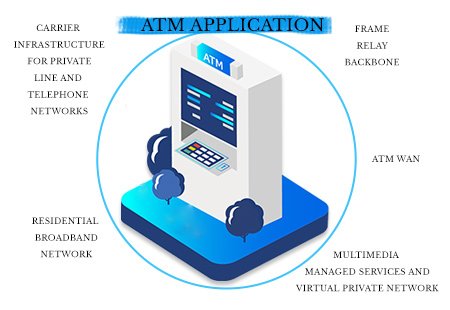It can call relay efficiently and can transmit information including data, voice or video that is conveyed in fixed six packets known as cells. The network is connected and cells get transferred asynchronously. BookMyEssay is the right platform that can offer you the best help for assignment on ATM Implementation and you will be able to secure top grades.
ATM Applications
The ATM applications are highlighted when you ask, "do my homework for me on ATM Implementation" as follows:
- ATM WAN: It is used as WANs for sending calls to long distances. The router serves as an end-point between the networks.
- Frame relay backbone: Frame relay services are networking infrastructure for various data services and it enables frame-relay ATM to an internetworking service.
- Multimedia managed services and virtual private networks: It helps to manage LAN, ATM, and video services and it has the capability to offer complete virtual private networking including integrated multimedia access.
- Residential broadband network: ATM offers the networking infrastructure for establishing residential broadband services for highly scalable solutions.
- Carrier infrastructure for private line and telephone networks: To make SONET/SDH fiver infrastructure more effective by building an ATM infrastructure to carry out private-line and telephonic traffic.
Why ATM Network?
Some of the reasons to use ATM networks are discussed in our ATM Implementation assignment paper help are as follows:
- It is driven by performance needs and integration services of data networking and telephony.
- Internet does not offer quality services, however, it is cheap and flexible
- Telephone networks are expensive to boot and supports quality services.
- ATM networks support a wide range of quality services at a reasonable cost. It can work similarly to the internet and the telephone network.
ATM Layers
The ATM Layers are as follows:
ATM Adaption Layer or AAL
It can isolate higher protocol layers from ATM processes. It converts user data to cells and thereafter segments it to 48-byte payloads. It helps to map applications such as data, and voice to ATM cells.
Physical Layer
It manages transmission that is dependent on the medium. This layer is divided into two layers-transmission convergence sublayer and medium-dependent sublayer. Its main functions are as follows:
- It converts cells to a bitstream
- It tracks the cell boundaries of ATM
- It controls the receipt and transmission of bits in a physical medium
ATM Layer
It handles switching, transmission, cell header processing, congestion control and it can share virtual circuits through the physical link. It passes cell via ATM network called cell relay thus using VCI and VPI information in a cell header. Our best Australian writers have immense experience in this field and they can offer a proper explanation for every topic.





 3 Bellbridge Dr, Hoppers Crossing, Melbourne VIC 3029
3 Bellbridge Dr, Hoppers Crossing, Melbourne VIC 3029

